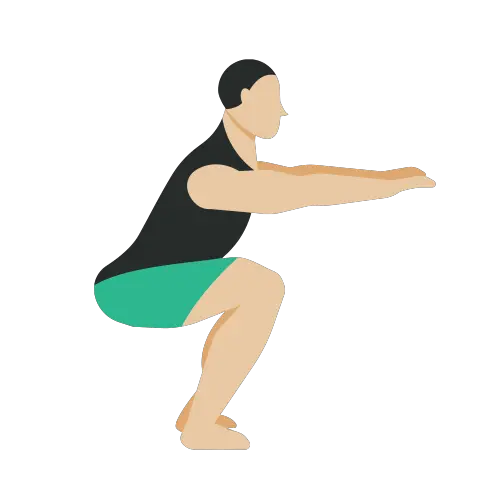Have you been looking for a versatile and effective exercise to strengthen your lower body while also improving your mobility and stability? Look no further than the heel elevated goblet squat. This variation of the traditional squat offers a range of benefits and can be easily incorporated into your workout routine, whether you’re a beginner or a seasoned fitness enthusiast.
Heel Elevated Goblet Squat Muscles Worked
The heel elevated goblet squat is a dynamic exercise that targets multiple muscle groups in the lower body and core. By elevating the heels and holding a weight at chest level, this variation of the squat places particular emphasis on certain muscles while engaging others for stabilization. Here’s a breakdown of the primary muscles worked during heel elevated goblet squats:
- Quadriceps: The quadriceps, located at the front of the thigh, are heavily engaged during heel elevated goblet squats. Elevating the heels shifts the focus onto the quadriceps, making them work harder to extend the knees and straighten the legs during the upward phase of the squat.
- Glutes: The glutes, comprising the gluteus maximus, gluteus medius, and gluteus minimus, play a significant role in hip extension and stabilization during heel elevated goblet squats. These muscles are activated as you push through the heels to return to the standing position, effectively engaging the posterior chain.
- Hamstrings: Although not the primary focus of the exercise, the hamstrings, located at the back of the thigh, are also recruited during heel elevated goblet squats to assist in hip extension and knee flexion. They work synergistically with the glutes to control the descent and ascent phases of the squat.
- Calves: The calf muscles, including the gastrocnemius and soleus, are activated to a greater extent when the heels are elevated during squats. They help stabilize the ankles and provide additional support during the movement, particularly during the upward phase when pushing through the balls of the feet.
- Core: Maintaining proper form during heel elevated goblet squats requires significant core stabilization. The muscles of the core, including the rectus abdominis, obliques, and transverse abdominis, work together to stabilize the spine and pelvis, preventing excessive arching of the lower back and promoting overall balance and stability.
Benefits of Heel Elevated Goblet Squat
Improved Range of Motion
One of the primary advantages of performing heel elevated goblet squats is the increased range of motion it provides compared to traditional squats. By elevating your heels slightly, you allow for deeper squatting, which targets your muscles more comprehensively.
Increased Quadriceps Activation
Elevating your heels during squats shifts the emphasis onto your quadriceps, making this exercise particularly effective for developing stronger and more defined thighs.
Enhanced Core Engagement
Maintaining proper form during heel elevated goblet squats requires significant core stability. As a result, this exercise not only strengthens your legs but also engages your core muscles, contributing to improved overall stability and balance.
Better Ankle Mobility
For individuals with limited ankle mobility, heel elevated goblet squats can be a game-changer. By raising your heels, you reduce the demand on ankle flexibility, allowing you to perform squats with greater ease and comfort.
How to Perform Heel Elevated Goblet Squat
Proper Equipment Setup
To perform heel elevated goblet squats, you’ll need a sturdy surface to elevate your heels, such as weight plates or a wedge. Additionally, you’ll require a dumbbell or kettlebell to hold at chest level.
Correct Body Positioning
Start by standing with your feet shoulder-width apart, toes slightly turned out. Place the weight on the floor and position yourself so that your heels are elevated on the chosen platform.
Step-by-Step Execution
- Hold the weight close to your chest with both hands, elbows pointing down.
- Engage your core and maintain a straight back as you lower your body into a squat position.
- Keep your knees aligned with your toes and lower until your thighs are parallel to the ground or below, ensuring your heels remain elevated throughout.
- Push through your heels to return to the starting position, squeezing your glutes at the top of the movement.
- Repeat for the desired number of repetitions.
Common Mistakes to Avoid
Arching the Lower Back
One common mistake during heel elevated goblet squats is arching the lower back. To prevent this, focus on keeping your core tight and your spine neutral throughout the movement.
Allowing Knees to Cave Inward
Another error is allowing the knees to cave inward, which can place unnecessary strain on the joints and increase the risk of injury. Concentrate on keeping your knees in line with your toes throughout the exercise.
Using Excessive Weight
Attempting to lift too much weight can compromise your form and increase the likelihood of injury. Start with a lighter weight and gradually increase as you become more comfortable with the movement.
Variations of Heel Elevated Goblet Squat
Dumbbell Heel Elevated Goblet Squat
Instead of using a kettlebell, you can perform heel elevated goblet squats with a dumbbell held vertically against your chest.
Barbell Heel Elevated Goblet Squat
For those seeking a greater challenge, the barbell heel elevated goblet squat offers a more significant resistance load, requiring increased stability and strength.
Single-Leg Heel Elevated Goblet Squat
To further enhance balance and unilateral strength, try performing heel elevated goblet squats on one leg at a time.
Incorporating Heel Elevated Goblet Squats into Your Workout Routine
Frequency and Repetitions
Include heel elevated goblet squats in your lower body workouts two to three times per week, aiming for three to four sets of 8-12 repetitions.
Combining with Other Exercises
Pair heel elevated goblet squats with complementary exercises such as lunges, deadlifts, and calf raises to create a well-rounded lower body workout.
Tips for Success
Focus on Form Over Weight
Prioritize proper form and technique over lifting heavy weights. Performing heel elevated goblet squats with correct form is key to maximizing results and minimizing the risk of injury.
Gradually Increase Elevation Height
Start with a modest heel elevation height and gradually increase as your flexibility and strength improve.
Listen to Your Body
Pay attention to any discomfort or pain during the exercise and adjust as necessary. It’s essential to listen to your body and modify the movement to suit your individual needs.
Precautions and Considerations
Consulting a Professional
If you have any pre-existing medical conditions or concerns, consult with a healthcare professional before incorporating heel elevated goblet squats into your workout routine.
Adapting for Injury or Limitations
Modify the exercise if you experience any pain or discomfort, such as reducing the elevation height or using lighter weights.
Real-Life Benefits and Testimonials
Many individuals have experienced significant improvements in strength, mobility, and overall fitness by incorporating heel elevated goblet squats into their training regimen. From athletes to fitness enthusiasts of all levels, this exercise has proven to be a valuable addition to any workout routine.
Conclusion Of Heel Elevated Goblet Squat Muscles Worked
The heel elevated goblet squat is a highly effective exercise for targeting the lower body while simultaneously improving mobility, stability, and core strength. By incorporating this variation into your workout routine and following proper form and technique, you can experience a wide range of benefits and take your fitness journey to new heights. Check out more such health blogs on cable squats.
FAQs
Heel elevated goblet squats can be performed by individuals of all fitness levels, from beginners to advanced lifters. However, it’s essential to start with lighter weights and gradually progress to more challenging resistance as you become more comfortable with the exercise.
While heel elevated goblet squats can help improve ankle mobility and strengthen the muscles surrounding the knees, individuals with pre-existing knee or ankle issues should exercise caution and consult with a healthcare professional before attempting this exercise. Modifications may be necessary to accommodate individual limitations or injuries.
You can incorporate heel elevated goblet squats into your lower body workout routine by performing them alongside other exercises such as lunges, deadlifts, and calf raises. Aim to include this variation two to three times per week, adjusting the frequency and intensity based on your individual goals and fitness level.
To perform heel elevated goblet squats, you’ll need a sturdy surface to elevate your heels, such as weight plates or a wedge. Additionally, you’ll require a dumbbell or kettlebell to hold at chest level.
To maintain proper form during heel elevated goblet squats, focus on keeping your core tight, your spine neutral, and your knees aligned with your toes throughout the movement. Avoid arching your lower back or allowing your knees to cave inward, and listen to your body for any signs of discomfort or strain.

